Discovering the Cassowary: A Look into the Fascinating Species

Introduction
The cassowary is a species of flightless birds found in the tropical forests of Australia, New Guinea, and surrounding islands. They are the heaviest bird in Australia, reaching up to 6 feet in height and weighing up to 90 pounds. The cassowary is a solitary animal, spending most of its time alone in the dense rainforest. Despite their size, they are surprisingly agile and fast, capable of running up to 30 miles per hour. Cassowaries are also known for their bright, blue-green feathers, which are used for display and courtship.
Habitat and Diet
Cassowaries are most commonly found in the tropical rainforests of northeast Queensland, Australia, as well as in New Guinea and nearby islands. They prefer to stay in dense vegetation, where they can hide from predators and find food. Cassowaries are omnivorous, meaning they eat both plants and animals. They mainly feed on fruits, seeds, and small animals such as insects, frogs, and lizards. They also eat snails, spiders, and eggs from other birds.
Conservation Status
The cassowary is listed as a vulnerable species by the International Union for Conservation of Nature (IUCN). The population has been declining due to loss of habitat, hunting, and predation by dogs. In Australia, the cassowary is protected under the Wildlife Protection Act of 1975. In New Guinea, the species is listed as endangered, and there are several protected areas where the birds can be seen.
Behavior and Interactions
Cassowaries are shy and solitary animals, with males living alone and females living with their young. During courtship, males call loudly and display their colorful feathers. They also use their sharp claws to fight other males for territory and mates. Though they can be aggressive, cassowaries are also gentle and curious creatures that can be seen eating out of people’s hands.
Conclusion
The cassowary is a fascinating species of flightless bird found in the tropical forests of Australia, New Guinea, and surrounding islands. They are the heaviest bird in Australia and are surprisingly agile and fast. They are a vulnerable species due to habitat loss, hunting, and predation by dogs. However, they are still a sight to behold in the wild and can be seen eating out of people’s hands. With continued conservation efforts, the cassowary population can be protected and preserved for future generations.





